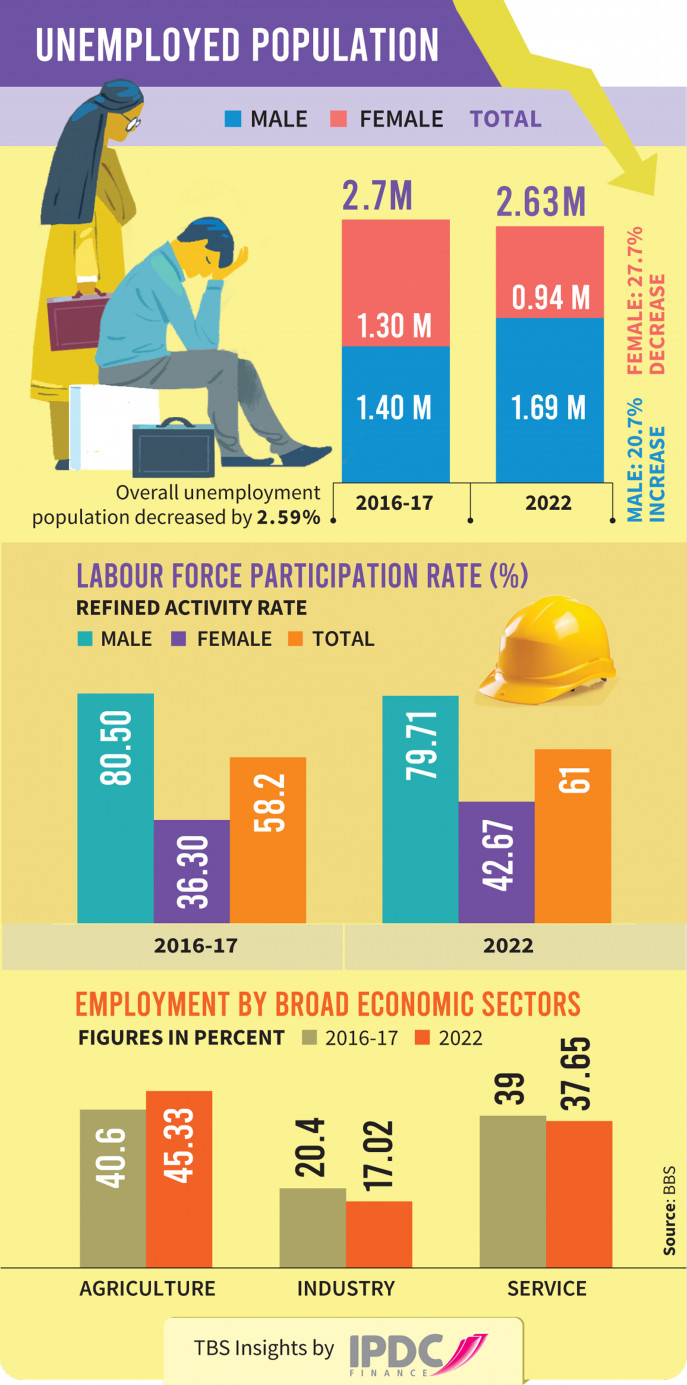
The unemployment rate in Bangladesh declined to 3.6% in 2022 mainly riding on an upward trend in women’s and youths’ participation, down from 4.2% reported in the previous survey conducted in 2016-17, shows the latest Labour Force Survey by the Bangladesh Bureau of Statistics (BBS).
The number of unemployed people in the country has decreased by 70,000 over the past five years, and now stands at 26.30 lakh.
Employment in Bangladesh refers to a situation where individuals who do work for a wage, salary, commission, tips or any other pay, even if only for one hour in the previous week. If the answer is “no” then the person is unemployed, according to BBS.
The latest survey revealed a shift in employment trends, with more people engaged in farm activities and service sector, while employment in industries dropped.
Women’s participation in the workforce has increased in 2022, which is reflected at the national level.
Also, youth labour force increases, which could lead to economic growth and increased competitiveness.
The survey, which was released on Wednesday in presence of the minister and the state minister for planning, was the first-ever quarterly survey, conducted in Bangladesh, and the country will continue to conduct such surveys going forward.
According to the Labour Force Survey 2022, the total labour force is 73.41 million, including 47.48 million males and 25.93 million females. And a 9.91 million labour force has joined the market in the last five years.
The survey shows that the total population outside the labour force aged 15 and above is 46.9 million. And the population outside the labour force has increased by 1.4 million over the past five years.
Prof Selim Raihan, executive director of Sanem, said this unemployment figure may not accurately reflect the true level of unemployment in the country due to the prevalence of underemployment and informal employment.
“If underemployment is taken into account, unemployed people will be around 1 crore instead of 26 lakh,” he told The Business Standard.
According to Raihan, an economics professor at Dhaka University, youth unemployment is a matter of significant concern, given that the previous survey showed a rate of 10%, which is much higher than the overall unemployment rate of 4.2%.
Commenting on the survey, both Planning Minister MA Mannan and State Minister for Planning Shamsul Alam said that the poverty of the country has decreased during the pandemic and the rate of unemployment has also dropped at the same time.
MA Mannan referred to a survey conducted by the state-owned think tank Bangladesh Institute of Development Studies (BIDS) during the Covid transition period, which shows the poverty rate and extreme poverty rate in Dhaka city decreased during the pandemic.
“Because factories were not closed 100% in our country during the Covid pandemic. Lockdowns were enforced at a limited scale. At the same time, government incentives were introduced. And it has played a role in reducing poverty,” he added.
Shamsul Alam said, “Covid has taught us a new kind of lesson and played a role in reducing the number of unemployed.”
Labour force in agriculture increased
According to the survey, the total working population as of 2022 is 70.78 million, of which males are 45.79 million and females are 24.99 million.
The labour force employed in the agricultural sector has increased to 45.33% from 40.6% in the fiscal 2016-17.
People employed in the industrial sector decreased from 20.4% to 17.02%, while employment in the service sector increased from 23.7% to 26.65%.
In this context, the state minister for planning said that even if there is a decrease in employment in the industrial sector, it is temporary. Employment in the agricultural sector will decrease at some point.
During the Covid-19 pandemic, a significant portion of city people migrated to villages and engaged in some productive work. As a result, employment in farm activities has increased. New crops and fruits are now being produced in the country, he added.
“Employment in our manufacturing industry including RMG has been stuck at 40 lakh for many years,” he said, explaining reasons why overall employment in manufacturing sector has not increased
Md Ehsan-E-Elahi, secretary of the labour and employment ministry, said, “Now industries are not getting enough workers, especially skilled workers. Many, including BGMEA and BKMEA have expressed concerns about this.”
Female participation
Female participation in Bangladesh’s labour force has increased to 42.68% in 2022, up from 36.3% five years ago, with women getting engaged in work in a bigger way especially in rural areas.
Rural participation of women in work is 50.88% and 23.58% in urban areas, says the BBS survey.
Shamsul Alam said Bangladesh has surpassed India and Pakistan in female labour participation. “This is our new dimension. Female labour participation in Bangladesh is almost double that of these two neighbouring countries.”
Planning Minister Mannan also hailed higher participation of women in work, saying Bangladesh is the best in South Asia in terms of female labour participation.
“It is good for our economy. But housewives were not considered as a labour force here. If the work done by housewives were added, our GDP would have increased in size. Many developed countries of the world are valuing the work of housewives,” the minister said.

